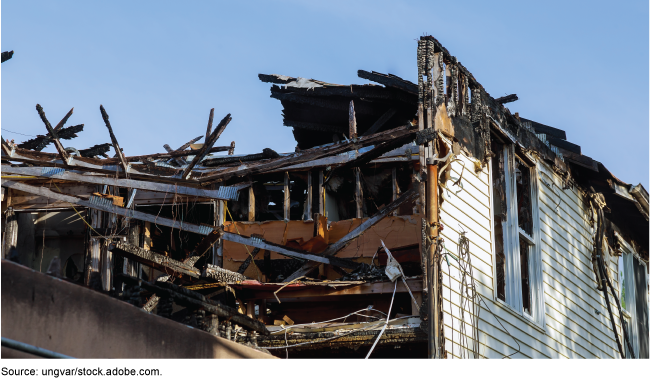Disaster Loan Program: Enhanced Procedures and Data Needed to Address Duplication of Benefits
Fast Facts
Disaster loans from the Small Business Administration can help survivors rebuild and recover from property and home damages. However, survivors sometimes receive assistance from other sources that can exceed their eligible losses, resulting in a duplication of benefits.
SBA is required to resolve cases of duplication when it's in the government's best interest to recoup excess funds. When they find duplicative benefits, SBA staff are required to inform disaster loan recipients and explain what might be done to resolve the case. But SBA doesn't have procedures to ensure that cases get fully resolved.
Our recommendations address this, and more.

Highlights
What GAO Found
Duplication of disaster benefits occurs when disaster survivors receive compensation from multiple sources—such as insurance and federal aid—that exceeds their total eligible losses. To prevent this, the Small Business Administration (SBA) requires borrowers to self-report any additional assistance they have received when applying for an SBA disaster loan. SBA uses the information to determine the maximum loan amount needed to cover eligible losses. SBA also contacts borrowers before each loan disbursement to check whether they have received any other potentially duplicative compensation, such as insurance payments or grants. If duplication of benefits is identified, SBA notifies borrowers of corrective actions they may take to resolve the issue.
SBA has identified cases of duplicative disaster assistance (see table), but SBA could not determine whether or how the duplication was resolved or how much over-disbursement was recovered in these cases. SBA is statutorily required to recover any duplicative benefits that it has provided to disaster assistance recipients when deemed in the government's best interest. However, it does not have documented procedures outlining how its staff should ensure borrowers take corrective actions to fully resolve such cases. Establishing documented procedures could better ensure that SBA staff fully and appropriately resolve cases of duplication and identify recovered amounts.
SBA Disaster Loans with Identified Duplication by Date Identified, June 2020–Dec. 2023
|
Time period |
Loans with duplication identified |
|---|---|
|
June 2020–Sept. 2020 |
59 |
|
Oct. 2020–Sept. 2021 |
738 |
|
Oct. 2021–Sept. 2022 |
592 |
|
Oct. 2022–Sept. 2023 |
541 |
|
Oct. 2023–Dec. 2023 |
57 |
|
No date provided |
3 |
|
Total |
1,990 |
Source: GAO analysis of Small Business Administration (SBA) data. | GAO-25-107608
Notes: SBA could not provide data before June 2020 or after December 2023 due to tracking system transitions. For more details, see table 3 in GAO-25-107608.
Additionally, SBA's ability to track these duplications is limited. SBA relies on borrower self-reporting and data-sharing with federal agencies to detect duplications. However, its data management systems cannot automatically retrieve detailed case data. As a result, staff must manually review text fields in individual loan records to verify the status of duplicative benefits, repayment actions, or adjustments made, leading to inconsistencies and inefficiencies. By enhancing data collection and accessibility, SBA could better monitor and address duplication of benefits involving disaster assistance, and thereby improve efficiency and help ensure recovery of duplicate funds. Enhanced data collection would also strengthen its ability to evaluate the effectiveness of its procedures.
Why GAO Did This Study
Natural disasters cause billions of dollars in damage to U.S. communities each year. SBA's Disaster Loan Program helps borrowers, including homeowners and businesses, rebuild or replace damaged property or continue business operations.
The Joint Explanatory Statement accompanying the Further Consolidated Appropriations Act, 2024, includes a provision for GAO to examine duplication of benefits in SBA disaster assistance. This report examines (1) SBA policies and procedures for preventing, identifying, and resolving cases of duplicative benefits, and (2) SBA data on such cases and SBA efforts to resolve them.
GAO analyzed SBA disaster loan data from June 2020 through December 2023—the latest available data. GAO also reviewed related documentation from SBA and other federal agencies, and interviewed agency officials.
Recommendations
GAO recommends that SBA (1) develop documented procedures for resolving cases of duplicative disaster benefits and (2) enhance the collection and accessibility of its data on these cases. SBA partially agreed with the first recommendation and agreed with the second. SBA stated that it would address both recommendations.
Recommendations for Executive Action
| Agency Affected | Recommendation | Status |
|---|---|---|
| Small Business Administration | The Administrator of SBA should ensure that the Associate Administrator for the Office of Capital Access develops documented procedures for resolving cases of duplicative benefits after a disaster loan has begun disbursement. (Recommendation 1) |
When we confirm what actions the agency has taken in response to this recommendation, we will provide updated information.
|
| Small Business Administration | The Administrator of SBA should ensure that the Associate Administrator for the Office of Capital Access enhances the collection and accessibility of data on cases of duplication of benefits in disaster loans and their resolution. (Recommendation 2) |
When we confirm what actions the agency has taken in response to this recommendation, we will provide updated information.
|
